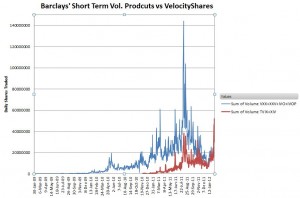Barclays had the short term volatility ETF space to itself from January 2009 until November 2010 with their VXX long and XXV short ETNs. On November 30th, 2010 VelocityShares came on the scene with three new short term funds: 1X long VIIX , 2X long TVIX, and -1X daily inverse XIV. Fifteen months later, on February 14th, the combined daily volume of these VelocityShares ETNs exceeded Barclays. And it wasn’t a close thing—52 million vs 45.4 million shares traded.
In the ETF world a near two year head start is hard to overcome. Barclays’ VXX in particular has become very successful, trading at least 5 to 10 million shares a day and spiking as high as 140 million. While VIIX was essentially a clone of VXX, VelocityShares’ two other offerings were different. In the volatility space the 2X leveraged TVIX seemed a bit outrageous, but it has turned out to be what traders wanted—an investment that tracks the VIX index respectably well.
VelocityShares’ XIV differed from Barlcays’ XXV, and its follow-ons IVO & IVOP by targeting an inverse daily percentage performance, instead of acting like a true short. The two approaches battled it out for a while. The inverse daily percentage approach has path dependencies that prevent it from exactly mirroring the target index, but Barclays’ true short approach suffers from variable leverage. At inception true short volatility ETNs are 1X funds, but their leverage (or “participation” as Barclays calls it) decreases if volatility goes down and increases when volatility is high—not the ideal characteristic for an inverse volatility fund.
During September 2011’s volatility spikes IVO’s leverage accelerated to 3X right before it collided with its $10 termination point. Barclays was ready with its replacement IVOP, but then it had a near death experience when it dropped from $20 to $11.3 just eleven days after its inception—again driven by high leverage. If VXX had gone just 4% higher IVOP would have terminated too. Not surprisingly investors have shifted to the daily percentage approach. XIV has a termination provision too, but it’s tied to a -80% percentage move that’s better suited to the rough-and-tumble world of volatility. On February 14th the combined volume of XXV+IVOP was 40 thousand, compared to 15 million for XIV…
Credit Suisse AG, the issuer of VelocityShares’ notes has to like the roughly balanced assets under management (~$400 million) between TVIX and XIV. The asset risk on the short side naturally cancels the risk on the long side—reducing the amount of hedging they have to do.
I’m surprised that Barclays has not responded to VelocityShares’ challenge with similar funds. They are innovators that were first to market, but apparently they just can’t bring themselves to use the daily percentage move approach.
VelocityShares continues to introduce new products. In October they added ETNs targeting the commodities space,with 3X long and 3X inverse funds for gold, sliver, platinum, and palladium, and just last week they added 3X long and 3X inverse products for Brent and crude oil, natural gas, and 2X long and 2X inverse for copper. See this IndexUniverse post for more information.
Coming up soon I’m guessing VelocityShares will introduce six new Volatility ETNs based on new index methodologies they created in conjunction with S&P indices. These indexes offer dynamic volatility exposure similar to Barclay’s innovative XVZ S&P 500 Dynamic VIX ETN which provides a volatility investment suitable for medium to long term timeframes.
Disclosure: long XIV and XVZ



hi Vance, I watched the VIX index, VXX, and XIV movement everyday.
In recent week, it seems like the VIX futures is in the backwardation condition, while the fact it’s always in contango.
VIX index down, VXX up, XIV down.
From what I learned, in contango situation, when the VIX Index down, VXX should goes down, and XIV should goes up.
So,is there any particular reason for this?
Hi Hendra, I think the most important thing to watch is the absolute value of the futures. Contango and backwardation are secondary effects that are important, but they don’t drive the price of VXX/ XIV as much as you might think. This last week the overall level of the futures was rising quickly, even though the term structure was still in contango.
— Vance
thank you Vance for your answer, it helps me a lot to understand more and more about these ETN
have a great day!
Not sure if I agree. Contango & backwardation are the name of this game. I remember seeing your newer post, stating that the VIX / VXV ratio thing has stopped working since 2013?
Is there a reason why VIIX has options and TVIX does not, despite the fact that TVIX has much more AUM and volume?
Hi Andrew, Frankly I think the options market maker community is just scared of it. Any underlying that can routinely move 25%+ in a day would be a scary thing to hedge.